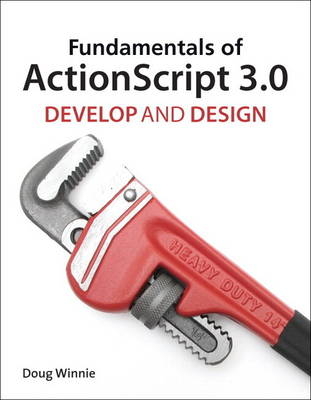
Fundamentals of ActionScript 3.0
Peachpit Press Publications (Verlag)
978-0-321-77702-7 (ISBN)
- Titel ist leider vergriffen;
keine Neuauflage - Artikel merken
Doug Winnie draws on the experience he’s gained from his years as an educator to teach not only what ActionScript can do, but also to show how the code works. This gives the reader a deeper understanding of how ActionScript functions, and gives them the power to come up with original solutions when creating their own projects.
Doug’s book dives right into the concepts of manipulating Flash objects and the fundamentals of functions and mathematical operators. After presenting events and using scripts to control the Flash timeline, classes and conditionals are covered in depth.
The final part of the book covers creating desktop applications with Adobe AIR, developing mobile applications, and working with external code libraries. Real-world projects are sprinkled generously throughout the book and Appendices include information on debugging, deciphering documentation, and using Adobe Flash Builder as an ActionScript development environment.
Introduction
Part 1: Getting the Fundamentals
Chapter 1: Accessing and Manipulating Objects
Accessing Objects
Sending Messages to the Output Console
Changing Object parameters
Chapter 2: Dynamically Adding Objects to the Stage
Creating Named Library Assets
Creating new objects on the stage
Working with Comments
Chapter 3: Working with Functions
Fundamentals of Functions
Accepting values in Functions
Returning Values from Functions
Things to Remember about Functions
Chapter 4: ActionScript and Math
Mathematical Operators
Combined Assignment Operators
Increment and Decrement Operators
Order of Operations
Using Parenthesis to Force Order
Chapter 5: Creating Events
Events: Explained
Creating a Mouse Event Handler
Chapter 6: Using Timeline Scripting with Mouse Events
Controlling Timeline Playback
Using the Event Callback Object and Understanding Scope
Using Frame Labels
Single Quotes vs. Double Quotes
Working with Simple Callback Functions
Chapter 7: Creating a Timer
Chapter 8: Project: Creating a Clock
Part 2: The Basics of Classes
Chapter 9: What is a Class?
What is a Class
Overview of a Class
Variables Revealed
Creating a Class
Chapter 10: Building Out the Class
Parts of a Class
Import Statement
Class Statement
Class Constructor
Creating the Instance
Adding Constructor Properties
Customizing the Button Label
Customizing Multiple Properties
Creating Methods
Accessing Methods from Outside the Class
Chapter 11: Doing More with Classes
What is the public keyword for?
Restricting Access with private
Naming Best Practices for Private Members
Getters and Setters: Keeping things Polite
Creating Getter and Setter Methods
Using the get and set Statements
Creating the Document Class
Chapter 12: Project: A Virtual Zoo (NEW)
Part 3: Responding to Conditions
Chapter 13: Conditionals
Boolean Variables
Testing for Equality
Testing for Inequality
Demonstrating Equality and Inequality
Adding Feedback
Testing Conditions
The if Statement
The if…else Statement
The if…else if Statement
Chapter 14: Creating Groups of Objects and Repeating Actions Using Loops
What are Loops
The for Loop
Creating Groups of Items with Arrays
Looping through Arrays
Controlling the Flow of Loops with break and continue
Chapter 15: Project: Tilr
Chapter 16: Advanced Boolean Logic and Random Numbers
Logic Operators
The AND Operator
The OR Operator
Building Complex Conditionals
Generating Random Numbers
Project: DiceOut!
Part 4: Working with More Events
Chapter 17: Working with Text and the Keyboard
Working with Text Fields
Understanding Font Embedding
Customizing the Text Style
Managing Conditions with switch Blocks
Differences between Code Types: Key Codes versus Character Codes
Recognizing Special Keys
Chapter 18: Project: Creating a Quiz
Creating the Quiz Layout
Creating the KeyboardEvent Handler
Uncoupling the Quiz
Chapter 19: Desktop Applications with Adobe AIR
Creating a Desktop Project
Responding to Desktop Events
Understanding Differences Between Desktop and Browser Applications
Customizing the Look of your Application
Chapter 20: Project: Bare Bones, A Desktop Application
Chapter 21: Mobile Applications with Adobe AIR
Configuring your environment for Android
Configuring your environment for iOS
Working with Multitouch Events
Working with the Accelerometer
Creating Adaptive Layouts using ActionScript
Testing and Debugging your Application
Project: Mini Bones, A Mobile Application
Part 5: Organizing your Code and Working with External Code Libraries
Chapter 22: Understanding Packages
Chapter 23: Using Interfaces
Chapter 24: Extending Text Quality with TLF
Capabilities of TLF
Integrating TLF into your project
Working with Text using TLF
Chapter 25: Working with Third Party Libraries
How to import Third Party Libraries
Working with SWCs vs. Class Packages
The Hype Framework
Adding Hype to your Project
Creating your first Hype Project
Appendix: Understanding ActionScript Debugging
The Debug Interface
Understanding Breakpoints
Understanding Watchers
Capturing Errors and Dealing with them
Working with Runtime Errors
Appendix: Deciphering ActionScript Documentation
The Adobe Community Help Client
How to find the help you need
Understanding the contents of a Class documentation file
Working with Sample Code
Appendix: Diving Deep with Flash Builder 4.5
Using Flash Builder with Flash Professional
Creating ActionScript Projects in Flash Builder
Working with Exported SWCs from Flash Professional
Coding Shortcuts
Quick Reference Guide
Glossary
Index
| Erscheint lt. Verlag | 21.7.2011 |
|---|---|
| Verlagsort | Berkeley |
| Sprache | englisch |
| Maße | 188 x 231 mm |
| Gewicht | 1040 g |
| Themenwelt | Informatik ► Office Programme ► Outlook |
| Mathematik / Informatik ► Informatik ► Web / Internet | |
| ISBN-10 | 0-321-77702-6 / 0321777026 |
| ISBN-13 | 978-0-321-77702-7 / 9780321777027 |
| Zustand | Neuware |
| Informationen gemäß Produktsicherheitsverordnung (GPSR) | |
| Haben Sie eine Frage zum Produkt? |
aus dem Bereich


